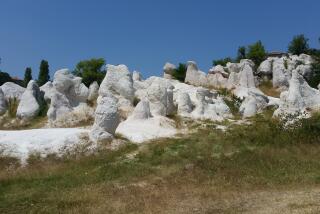Book review: ‘The Selected Letters of Charles Dickens’
- Share via
The Selected Letters of Charles Dickens
Edited by Jenny Hartley
Oxford University Press: 458 pp., $34.95
This is the bicentennial year of Charles Dickens’ birth. We need no reminder of his eminence as novelist, but there are celebrations of his other attainments as well. “The Selected Letters of Charles Dickens” is part of that. As its editor observes, a 12-volume edition of letters already exists; it took from 1965 to 2002 to compile the British Academy Pilgrim Edition “The Letters of Charles Dickens.” Although in September 1860 the writer made a bonfire of personal papers in a field at his house, Gad’s Hill, some 14,000 missives survived. The Pilgrim Edition contains them all (newly discovered letters have been published as supplements in the journal the Dickensian); this new edition of selections amounts to a “mere” 450 examples of the master’s epistolary prose. None but the librarian or obsessive devotee of Dickens’ work need thumb through all 12 volumes, but many will want this smaller edition to own. Its annotations are useful; its print is — for these eyes, at least — too small; it offers the author writ large.
Jenny Hartley describes her process admirably, and it’s worth quoting here:
“In reducing twelve volumes to one, and the 14,000 to 450, the main criterion is to show Dickens’ range as a letter writer. Readers who enjoy his fiction, his journalism, and his travel writing will appreciate his gifts in this fourth genre. On display here, notably in this condensed version, is the epistolary as the genre of exuberance. We see at first hand his indefatigable labors as a magazine editor, his exasperation with business arrangements (not always to his credit), his close involvement with philanthropic projects, his responses to issues of the day such as public hangings, and his alertness as a traveler. We can feel the warmth of his friendships, the richness of his social life, and, throughout, his pleasure in writing.”
Born in straitened circumstances, Dickens became one of the first “celebrity” authors — a bestseller with “The Pickwick Papers” by age 25 and never out of the limelight again. By the time he died, at 58, he was world-famous and besieged with mail; he answered correspondents promptly and received by his own attestation “three or four score letters every day.” He was proud of the elaborate flourish of his signature (though sometimes, for the sake of efficiency, he signed his letters “C.D.”) and endlessly attentive to detail — whether in the matter of illustrations for his books or what was served for supper in an inn.
While providing recipes for punch or plans for school reform he was precise; when writing of personal matters he was a good deal more guarded. He used nicknames often, calling himself — among other things — “The Mask,” “Victoria,” “Anti Pusey,” “The Congreve of the 19th Century” and “Dick the Doomed.” As those who attended his public performances report, he was also a bit of a ham.
Self-dramatizing, certainly. When 21 he wrote Maria Beadnell, who had cooled to his advances: “I have often said before and I say again I have borne more from you than I do believe any creature breathing ever bore from a woman before.” Two years later he was writing to Catherine Hogarth, whom he would marry, “were I to endeavour to embody the least of the feelings I entertain for you in words, it would be a useless, and hopeless attempt.”
This too is less than true; his feelings were always embodied in words and rarely uselessly. From first to final letter (Dickens continued to compose them till the day before his death), his sentiments are vivid — whether thanking Washington Irving for trans-oceanic praise or contacting such authors as Wilkie Collins, Hans Christian Andersen, George Eliot and Edward Bulwer-Lytton, whether describing the loss of his pet raven or a flooded river crossing or the nighttime assault on the end of a book.
To his lifelong friend and principal correspondent John Forster, he wrote: “After you left last night I took my desk upstairs, and writing until four o’clock this morning, finished the old story. It makes me very melancholy to think that all these people are lost to me for ever, and I feel as if I never could become attached to any new set of characters.”
He is describing here the death of little Nell, and one pleasure of this volume is to track his “set of characters” — Sam Weller and Oliver Twist and Pip and Martin Chuzzlewit and Mrs. Micawber and the rest — as they fire his imagination, then fade into cold print. He could be generous, uproarious, incisive or discursive and, on matters of business, quarrelsome. His every sentence has flair. He writes with reference to prison reform, the pleasures of a nighttime stroll and the travails of his journeys to America and Italy; he writes devastatingly of the failed poetic efforts of a man who sent him amateur verse: “lock up your papers, burn your pen, and thank Heaven you are not obliged to live by it.”
We as readers must be grateful that Dickens did not burn all of his papers and that he cherished his pen. This is no epistolary autobiography; the collapse of his marriage and the details of his love affair with Ellen Ternan, for example, are glossed over by the author or were perhaps fed to the blaze at Gad’s Hill. But the life of a mind is preserved; at the start of this third century, his language continues to live.
Delbanco is the author, most recently, of the novel “Sherbrookes” and the nonfiction study “Lastingness: The Art of Old Age.”
More to Read
The biggest entertainment stories
Get our big stories about Hollywood, film, television, music, arts, culture and more right in your inbox as soon as they publish.
You may occasionally receive promotional content from the Los Angeles Times.










